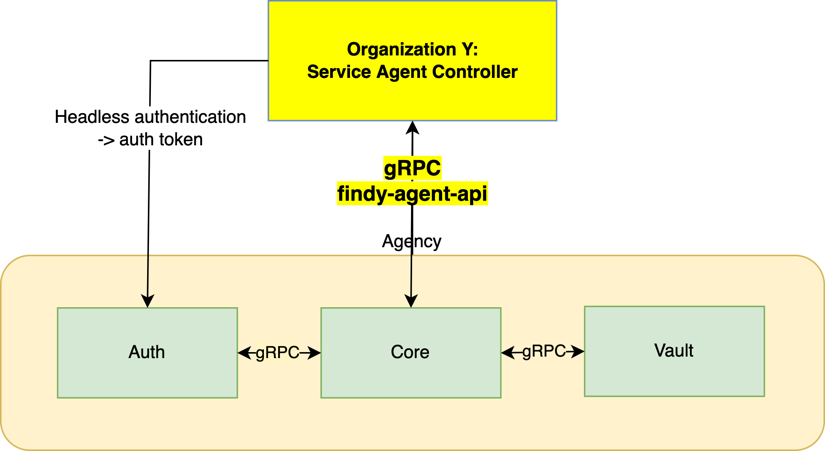The Findy Agency API

The gRPC API serves the client applications.
The Findy Agency clients can control their agents through the Findy Agency API over the high-performing gRPC protocol. The API design results from iterative planning and multiple development cycles. Initially, we implemented it using a custom protocol that utilized JSON structures and DIDComm as the transport mechanism. The initial design seemed like a good plan, as we got the chance to test the exact DIDComm implementation we were using to send the agent-2-agent messages (used in the credential exchange flows).
However, as we gained more experience using the API and the agent-2-agent protocol evolved as the community introduced Hyperledger Aries, we realized our API was too laborious, clumsy, and inefficient for modern applications.
One option would have been switching our API implementation to traditional REST over HTTP1.1. However, we wanted something better. We were tired of JSON parsing and wanted a better-performing solution than REST. We also wanted to be able to use the API using multiple different languages with ease. The obvious choice was gRPC, which provided us with protocol buffer messaging format, HTTP2-protocol performance gains, and tooling suitable for the polyglot, i.e., multilingual environment.
The technology choice was even better than we expected. Given that we have an agency installation available in the cloud, we can listen to agent events through the gRPC stream without setting up external endpoints using tools such as ngrok. Thus, gRPC streaming capabilities have considerably simplified client application development in a localhost environment. Also, the logic of how gRPC handles errors out-of-the-box have helped us trace the development time problems efficiently.
The API Contract
Our API contract defined with proto files resides in a separate repository, findy-agent-api. Using the gRPC tooling, one can take these proto files and compile them to several target languages, which enables the use of API structures directly from the target implementation.
A brief example is displayed below. We define the structures and an RPC call for schema creation in protobuf language:
// SchemaCreate is structure for schema creation.
message SchemaCreate {
string name = 1; // name is the name of the schema.
string version = 2; // version is the schema version.
repeated string attributes = 3; // attributes is JSON array string.
}
// Schema is structure to transport schema ID.
message Schema {
string ID = 1; // ID is a schema ID.
}
/*
AgentService is to communicate with your cloud agent. With the cloud agent
you can Listen your agent's status, create invitations, manage its running environment,
and create schemas and credential definitions.
*/
service AgentService {
...
// CreateSchema creates a new schema and writes it to ledger.
rpc CreateSchema(SchemaCreate) returns (Schema) {}
...
}
The protobuf code is compiled to target languages using gRPC tooling, and after that the structures can be used natively from the application code.
agent := agency.NewAgentServiceClient(conn)
r := try.To1(agent.CreateSchema(ctx, &agency.SchemaCreate{
Name: name,
Version: version,
Attributes: attrs,
}))
fmt.Println(r.ID) // plain output for pipes
log.info(`Creating schema ${JSON.stringify(body)}`);
const msg = new agencyv1.SchemaCreate();
msg.setName(body.name);
msg.setVersion(body.version);
body.attrs.map((item) => msg.addAttributes(item));
const res = await agentClient.createSchema(msg);
const schemaId = res.getId();
log.info(`Schema created with id ${schemaId}`);
The examples show that the code is simple and readable compared to making HTTP requests to arbitrary addresses and JSON manipulation. The code generated from the proto-files guides the programmer in the correct direction, and there are no obscurities about which kind of structures the API takes in or spits out.
Helpers and Samples
We have developed two helper libraries that contain some common functionalities needed for building API client applications. One is for our favorite language Go (findy-common-go), and the other is for Typescript (findy-common-ts) to demonstrate the API usage for one of the most popular web development languages.
These helper libraries make building a Findy Agency client application even more straightforward. They contain
- the ready-built proto-code,
- functionality for opening and closing the connection and streaming the data,
- utilities for client authentication, and
- further abstractions on top of the API interface.
There already exist two excellent example client applications that utilize these helper libraries. In addition to being examples of using the API, they are handy tools for accessing and testing the agency functionality.
Our CLI tool provides agent manipulation functionality through a command-line interface. It uses the agency API internally through the Go helper.

Example above shows how it is possible to use the CLI tool for chatting with web wallet user.
The issuer tool is a sample web service with a simple UI that can issue and verify credentials using the issuer tool’s cloud agent. It is written in Javascript and utilizes the Typescript helper.

Issuer tool provides functionality for testing different Aries protocols.
One is not limited to using these two languages, as using the API from any language with gRPC tooling support is possible. Stay tuned for my next post that describes our latest experiment with Kotlin.